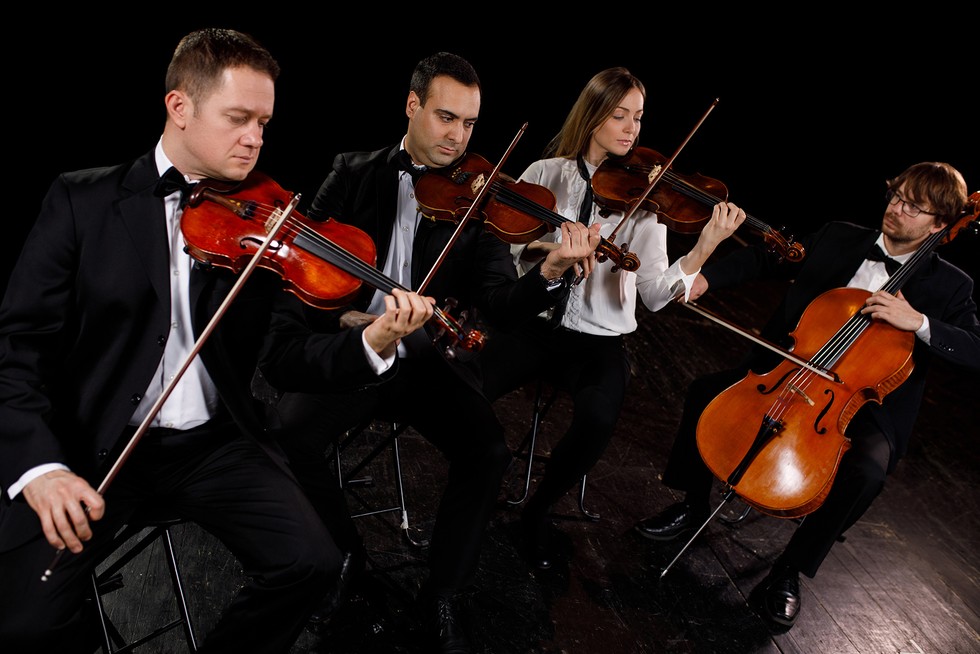What is chamber music?
What defines a piece of music as 'chamber music' - and where should you start your chamber music journey?

On your explorations of the classical music universe, you're likely to hear the term 'chamber music' a lot. But what does this term denote?
What makes a certain piece of music 'chamber music'? And how does this compare with other classical music forms, such as orchestral music or instrumental music?
Let's begin with a definition of chamber music, before moving on to recommend some great pieces of chamber music to start you off.
What is chamber music?
Classical music can be performed by all sorts of configurations of performers. At one end, you have solo music - a solo piano sonata or violin sonata, for example - which requires just one performer. At the other extreme, there's orchestral music - symphonies, concertos, tone poems and more. These works involve much larger forces - typically a full-size orchestra although in some cases, such as Mahler's massive Symphony no.8, a choir is added into the mix as well.
On this spectrum from soloist to full-size orchestra, chamber music sits somewhere in the middle. A piece of chamber music will typically contain parts for anything between two and nine players - although, as there are also chamber orchestras, the dividing lines between chamber music and orchestral music do get somewhat blurred.
At its smallest, chamber music can be for just two people. This will often, but not always, be a piano plus one other instrument, and will be known as a sonata. So, for example, Brahms - one of the undisputed masters of chamber music - wrote two cello sonatas (for cello and piano), two clarinet sonatas (clarinet and piano) and three violin sonatas (violin and piano).
What different groupings are common in chamber music?
We can use Brahms as an example, in fact, as we move through the various common chamber music configurations.
Chamber music for three performers is known as a trio, and the most common configuration is piano, violin and cello. Brahms wrote three piano trios (a fourth is usually attributed to him), but he also wrote a horn trio (horn, cello, piano) and a clarinet trio (clarinet, violin, piano).
Moving up to music written for four performers, the most common configuration here is the string quartet. Brahms wrote three of these - but he also wrote three piano quartets, in which a piano replaces one of the violins.
Moving up to music for five performers, Brahms wrote one of the most famous piano quintets (for piano and string quartet) in the repertoire. The German composer also composed a pair of string quintets (for two violins, two violas and a cello) and a brace of string sextets (adding another cello into the mix). Unsurprisingly, as the personnel increases, the sound becomes somewhat fuller and warmer.
Moving on up, we also have septets (such as that written by Beethoven), octets (Mendelssohn's wonderful work, composed at the age of just 16, is rightly the most famous) and even the nonet. The Czech composer Martinu wrote one of these, for wind quintet, string trio and double bass. The permutations are virtually endless!
Does chamber music tend to have certain moods?
Being composed for smaller forces than orchestral music, chamber music tends to have a more intimate, thoughtful, personal feel. If an orchestral work is generally more about the grander gestures, a piece of chamber music can seem more like a dialogue - between the performers, be they a piano trio or a string quartet, but also between those performers and the listener.
A good way of understanding the difference here is to compare Shostakovich's 15 symphonies with his 15 string quartets. Shostakovich's symphonies were written for public performance, and often in response to demands from the Communist regime. As such, they are big, often declamatory works. Think of the first movement of the Symphony No.7, 'Leningrad', for example. This is music to be heard in a large auditorium, and music with a big public message to convey - in this case, the resistance of the citizens of Leningrad people against the Nazi invaders.
In contrast, Shostakovich's string quartets are far more personal, intimate affairs. Many were not heard in public for years after their composition, and the contrast between the bombast of Symphony no.7 and the quiet angst of his String Quartet no.7 could hardly be more pronounced.
Five wonderful pieces of chamber music to get you started
Brahms: Violin Sonata No.1
Brahms was an accomplished pianist, and in all three of his violin sonatas the piano and the violin enjoy equal prominence. This first sonata was composed around the same time as his famous Violin Concerto.
More like this
Recommended recording:
Renaud Capuçon (violin), Nicholas Angelich (piano)
EMI
Beethoven: Piano Trio op. 97, 'Archduke'
One of the most serenely beautiful pieces of chamber music in the repertoire, the 'Archduke' Trio is one of 12 piano trios written by Beethoven. It's probably the most famous, with the 'Ghost' (named for its stealthy, twilit slow movement) a close second. The 'Archduke' gets its name from its dedicatee, Archduke Rudolph of Austria. The youngest of 12 children of the Holy Roman Emperor, Leopold II, Rudolf was a patron, friend, and composition student of Beethoven.
Recommended recording:
Beaux Arts Trio
Decca
Dvořák String Quartet No.12 'American'
Dvořák wrote 14 string quartets, of which number 12 is the best known. It was written in 1893, while the great Czech composer was living in the United States and working as director of the National Conservatory. It's perhaps best known for its yearning slow movement, which does seem to bear echoes of Native American music.
Recommended recording:
Panocha Quartet
Supraphon
Schubert: Piano Quintet, 'Trout'
Schubert's 'Trout' Quintet is full of joyous moments, and a gift for melody that is unmistakably Schubertian. Most piano quintets are scored for a piano and string quartet - Schubert's replaces the second violin with a double bass, and has a very distinctive soundworld as a result.
Recommended recording:
Kodaly Quartet, Jeno Jando (piano), Istvan Toth (double bass)
Naxos
Mendelssohn: Octet
Like the 'Trout' Quintet above, Felix Mendelssohn's String Octet contains many moments of infectious joy - not least the wonderful rising melody that dominates its first movement. Incredibly, Mendelssohn composed the piece at the age of just 16.
Recommended recording:
Hausmusik
Virgion Veritas
Authors

Steve has been an avid listener of classical music since childhood, and now contributes a variety of features to BBC Music’s magazine and website. He started writing about music as Arts Editor of an Oxford University student newspaper and has continued ever since, serving as Arts Editor on various magazines.




